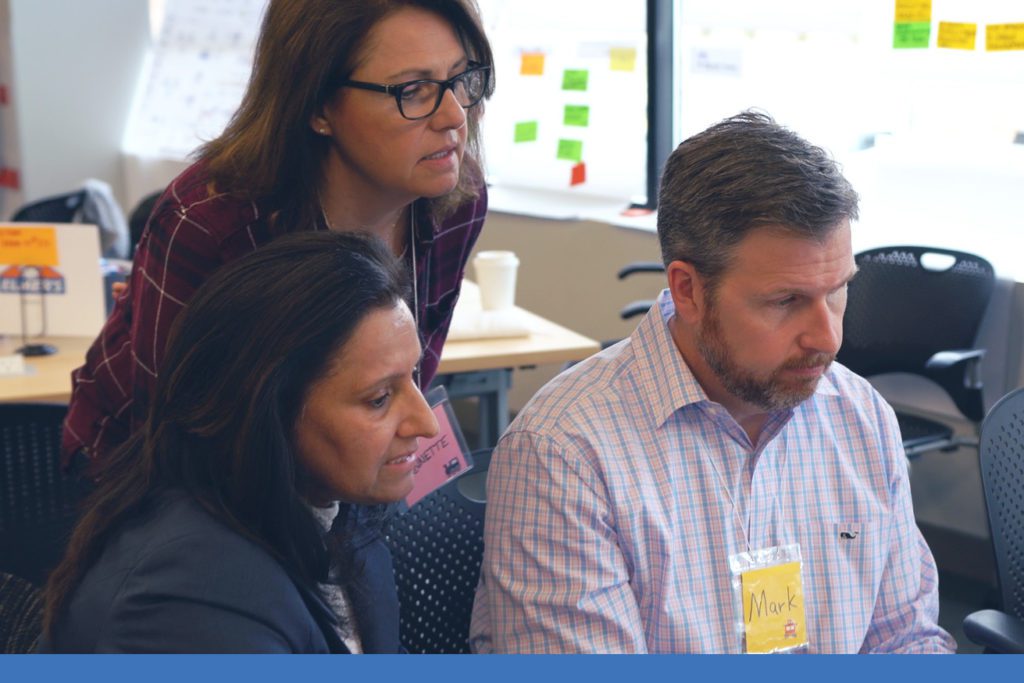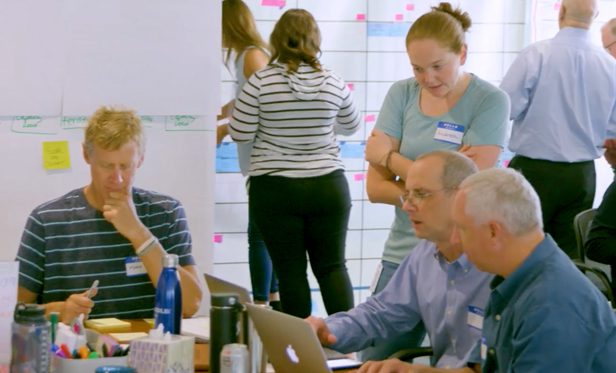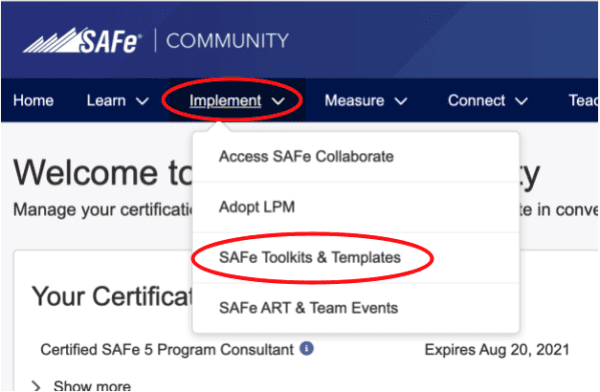
Welcome to the second post in our blog series about value stream identification in practice. Read the first post here about preparing for a successful Value Stream and ART Identification workshop.
When deciding where to launch an Agile Release Train (ART), it can be tempting to look within existing organizational boundaries. But, considering Lean-Agile Principle #10, which reminds us to organize around value, we must challenge ourselves to look outside of our comfort zone, and consider a team more optimally focused on delivering value.
In light of organizational politics, doing so can be challenging, if not scary. To help people focus on the task at hand, we’ve developed a Value Stream Identification workshop. It can be especially helpful for organizations that aren’t actively managing value streams. It also teaches all those who attend the Implementing SAFe® course the method to facilitate a value stream identification event.
All SPCs are trained to facilitate a value stream mapping activity. But executing these workshops is an art mastered only after you’ve done in-depth studies on the topic (check out Value Stream Mapping by Karen Martin and the SAFe Value Streams article to start), and have participated in several events under the guidance of a skilled practitioner.
If you’re a new SPC who doesn’t have the opportunity to co-facilitate an event, here are 10 tips to help make your first few value stream identification sessions more productive.
- Your operational value stream is probably bigger than you think.
When considering your operational value stream, remember the baseline definition of a value stream:
“… set of actions that take place to add value to a customer from the initial request through the realization of value by the customer. The value stream begins with the initial concept, moves through various stages of development and on through delivery and support. A value stream always begins and ends with a customer.”
Or, simply stated, from concept to cash.
In my years of helping organizations better understand their value streams, I’m often presented with initial maps that begin with input from an upstream process and end with an output to a downstream process. These aren’t value streams. To understand the value stream that your ART serves, it’s likely you need to zoom out from the perspective you’re most familiar with and consider the products and services that you support. I often direct people seeking to understand their value streams to start with the products or services section of their organization’s website. Another point of reference is the organization’s earnings report. A profit and loss statement will often represent the organization’s operational value streams.
- Your development value stream probably doesn’t follow organizational structures.
The development value stream, which is where your ART(s) will align, represents the design-build-test activities that support change within the operational value stream. Though it may be tempting to align development value streams and ARTs to the organization’s reporting structures, this is suboptimal. To determine the best development value stream alignment, you must first understand the complexity of the social network required to serve the operational value stream. How? By gaining clarity around architectural complexity, or understanding who must collaborate and how often to develop valuable changes to the operational value stream. Over time, our goal is to simplify and optimize both technical and business architectures. To start doing that, we must do our best to optimize for flow by reducing bottlenecks associated with handoffs and dependencies.
After identifying the operational value stream, we continue the conversation of value stream identification. This is where we seek to understand the systems that support the operational value stream, and which steps of it they interact with. The resulting picture will help us make a more informed decision of where to align our development value stream, and determine which type(s) of development value stream supports our operational value stream.
- Agreeing with operational and development value stream alignment is harder than you think.
Aligning around value, though critical to delivering better products and services to customers faster, is often challenging. In large enterprises that historically reward those who operate well within the hierarchy, the goal to operate well cross-functionally may feel difficult. The leaders of each functional area are asked to relinquish control of their organizations to better serve the customer. Though few will argue the merit of such a decision, we must be empathetic to the fact that this sort of change is difficult and often scary.
As a value stream identification workshop facilitator, you’ll find it valuable to proactively partner with the organization’s change management professionals to better understand the audience impacted by the workshop. These change professionals can help you better understand potential roadblocks and relationships. And they can recommend conversations you should have before the workshop to begin establishing trust, rapport, and purpose.

- You may have more guidance than you think.
Understand the nuance between value stream identification and value stream mapping. Value stream mapping is the art and science of defining, measuring, and optimizing value streams and capabilities over a long period of time. SAFe discusses value stream identification in the context of launching an ART. It’s where we need to have an informed discussion of the most logical place to launch an ART based on our best understanding of how value flows within our area of influence. Value stream identification doesn’t replace value stream mapping but certainly proves the need to invest in the latter.
Words matter. When referencing the one- to two-day workshop to determine the best place to launch an ART, be careful to reference this as value stream identification. A business architect’s job is to maintain and optimize value streams and their underlying capabilities. If they overhear a well-intended SPC state that they intend to map a value stream in a day or two, the SPC may inadvertently make an adversary out of a would-be supporter.
If the organization you’re working with happens to have business architects on staff, then there may be many more inputs available for the value stream identification conversation than you’d initially suspect. If so, seek to partner with the business architect and leverage the assets they’ve created. At the very least, the fact that these people exist indicates an undeniable organizational willingness to organize around value.
- Your business architecture will make it hard.
The architecture of a business, the flow of processes and interactions from concept to cash, will introduce complexity to the value stream identification exercise. Those complexities will typically represent years of acquisitions (without integration), good and bad relationships, canceled projects, partially finished projects, and other forms of organizational debt.
One of the most exciting—and troubling—things about an Agile transformation is how the new ways of working effectively shine a spotlight on issues that have been plaguing the organization for years. This is your opportunity to do something about it. Remember, the goal of value stream identification is to make an informed decision about the best, most logical place to launch your release trains. And those ARTs will evolve as the organization and architecture change. The goal isn’t to solve all of the organization’s challenges. But be aware of what you learn so that you can address the challenges and complexities moving forward.
- Your technical architecture will make it harder.
As messy as an organization’s business architecture may be, it’s likely that its technical architecture is worse. I’m talking about outdated systems, mainframe databases, hard-coded variables, and systems that we’re not too sure of what they do, but certain that it’s something important. The conceptual diagrams of most architectures tend to look like a hurricane.
Though challenging, this is also a huge opportunity. If the intent is to move faster and with greater stability, you must invest in reducing technical debt, refactoring, and modularizing their architecture. The value stream workshop can help identify some of the largest risks in the technical architecture and begin aligning people in a way that will support a better future state.
A good way to think of investments in business and technical architecture is to reflect on this video.

The goal of a race is to cross the finish line first. Pitstops are an obvious bottleneck in that process. To alleviate delays in the pit, engineers and team owners had to invest in developing specialized skills among the pit crew and specialized tools optimized for efficiency. And redesign the car with the intent of making every component on it as fast as possible. This includes the architecture for changing tires, fueling, and more. These days, nobody is polishing the windshield. Instead, the visor on the driver’s helmet has been optimized to minimize glare, shed water, resist fog, and with roll-offs for when things get messy.
What’s your organization’s race car? What investments do you need to make in the car so that your organization can achieve its goals? Investments in architecture aren’t optional. But you should make it clear how each investment will help the organization perform at a higher level.
- There are several types of operational value streams.
When considering operational value streams in an organization, it’s important to be aware that there are more than one type.
Fulfillment value streams represent the steps necessary to process a customer request, deliver a digitally enabled product or service, and receive remuneration. Examples include providing a consumer with an insurance product or fulfilling an e-commerce sales order.
Manufacturing value streams convert raw materials into the products customers purchase. Examples include consumer products, medical devices, and complex cyber-physical systems.
Software product value streams offer and support software products. Examples include ERP systems, SaaS, and desktop and mobile applications.
Supporting value streams include end-to-end workflows for various supporting activities. Examples include the life cycle for employee hiring and retention, supplier contracting, executing the annual budget process, and completing a full enterprise sales cycle.
- Development value streams support operational value streams.
While operational value streams may vary significantly depending on their purpose, the development value stream steps are fairly standard: design, build, validate, and release the systems that support the operational value stream as it delivers value to the end-user. The titles of the people who work within the development value stream will vary based on the specific type of work being done, but the responsibilities of the people involved with the development value stream will be aligned with the steps mentioned above.
- This is only a starting point.
Remember, the value stream identification workshop is designed to help people determine the best, most logical place to launch a release train. The decisions made in the workshop are a starting point. Following the workshop, reflect on opportunities to improve business operations, technical architecture, and the benefit of actively managing value streams for flow. Launching your first ART, development value stream, and portfolio is only the beginning of a lifelong pursuit to improve.
- Once you start, evolve and seek excellence.
As you continue to optimize your operations and architecture, expect that the ART configuration and team topology will evolve. As the Agile Manifesto reminds us, we hope to build resiliency through a commitment to responding to change by following a plan. And the SAFe House of Lean reminds us how important it is to commit to relentless improvement in pursuing value delivery.
Look for the next post in our blog series about how our voice of the customer sessions influenced Scaled Agile’s recent value stream work.
In the meantime, you can download the updated Value Stream and ART Identification Workshop toolkit by navigating to the “Implement” tab on the SAFe Community Platform, selecting “SAFe Toolkits & Templates,” then selecting “SAFe Value Stream and ART Identification Workshop Toolkit 5.1.”

About Adam Mattis

Adam Mattis is a SAFe Program Consultant Trainer (SPCT) at Scaled Agile with many years of experience overseeing SAFe implementations across a wide range of industries. He’s also an experienced transformation architect, engaging speaker, energetic trainer, and a regular contributor to the broader Lean-Agile and educational communities. Learn more about Adam at adammattis.com.
Share:
Back to: All Blog Posts
Next: Three Steps to Prepare for a Successful Value Stream Workshop